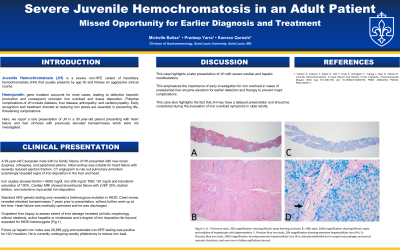Sunday Poster Session
Category: Liver
P1049 - Severe Juvenile Hemochromatosis in an Adult Patient
Sunday, October 22, 2023
3:30 PM - 7:00 PM PT
Location: Exhibit Hall


Michelle Baliss, DO
Saint Louis University
St. Louis, Missouri
Presenting Author(s)
Ahsan Siddiqui, MD1, Michelle Baliss, DO2, Pradeep Yarra, MD2, Kamran Qureshi, MD2
1Aga Khan University, St. Louis, MO; 2Saint Louis University, St. Louis, MO
Introduction: Juvenile hemochromatosis (JH) is a severe non-HFE variant of hereditary hemochromatosis (HH) that usually presents by the third decade of life and typically follows an aggressive clinical course. Hemojuvelin gene mutation accounts for most cases, leading to defective hepcidin production and consequent circulatory iron overload and tissue deposition. Potential complications of JH include diabetes, liver disease, arthropathy, and cardiomyopathy. Early recognition and treatment directed at reducing iron stores are essential in preventing life-threatening complications. We report a case of an adult who presented with cardiac failure as the initial manifestation of JH.
Case Description/Methods: A 39-year-old Caucasian male with no previous family history of HH presented with new onset dyspnea, orthopnea, and peripheral edema. Initial workup was notable for heart failure with severely reduced ejection fraction. CT angiogram to rule out pulmonary embolism surprisingly revealed signs of iron deposition in the liver and heart. Iron studies were notable for ferritin level > 6000 mg/dl, iron 209 mg/dl, TIBC 191 mg/dl and transferrin saturation of 100%. Cardiac MRI showed biventricular failure with LVEF 25%, biatrial dilation, and extensive myocardial iron deposition. Standard HFE genetic testing only revealed a heterozygous mutation in H63D. He was optimized on medical therapy for heart failure and was discharged when his symptoms improved. He subsequently underwent weekly phlebotomy as an outpatient to reduce iron load. Liver biopsy performed as an outpatient to assess extent of liver damage revealed cirrhotic morphology without steatosis, active hepatitis or cholestasis and a degree of iron deposition far beyond expected for H63D heterozygote. Follow up hepatic iron index was 28,885 µg/g and non-HFE genetic testing panel was positive for homozygous HJV mutation. His kids and siblings are being screened with Iron panel.
Discussion: This case highlights a later presentation of JH with severe cardiac and hepatic manifestations. This patient recalled a previous history of elevated liver enzymes during his early adulthood without further work-up at the time. This emphasizes the importance of early investigation for iron overload in cases of unexplained liver enzyme elevation for earlier detection and therapy to prevent major complications. This case also highlights the fact that JH may have a delayed presentation and should be considered during the evaluation of iron overload symptoms in older adults.
Disclosures:
Ahsan Siddiqui, MD1, Michelle Baliss, DO2, Pradeep Yarra, MD2, Kamran Qureshi, MD2. P1049 - Severe Juvenile Hemochromatosis in an Adult Patient, ACG 2023 Annual Scientific Meeting Abstracts. Vancouver, BC, Canada: American College of Gastroenterology.
1Aga Khan University, St. Louis, MO; 2Saint Louis University, St. Louis, MO
Introduction: Juvenile hemochromatosis (JH) is a severe non-HFE variant of hereditary hemochromatosis (HH) that usually presents by the third decade of life and typically follows an aggressive clinical course. Hemojuvelin gene mutation accounts for most cases, leading to defective hepcidin production and consequent circulatory iron overload and tissue deposition. Potential complications of JH include diabetes, liver disease, arthropathy, and cardiomyopathy. Early recognition and treatment directed at reducing iron stores are essential in preventing life-threatening complications. We report a case of an adult who presented with cardiac failure as the initial manifestation of JH.
Case Description/Methods: A 39-year-old Caucasian male with no previous family history of HH presented with new onset dyspnea, orthopnea, and peripheral edema. Initial workup was notable for heart failure with severely reduced ejection fraction. CT angiogram to rule out pulmonary embolism surprisingly revealed signs of iron deposition in the liver and heart. Iron studies were notable for ferritin level > 6000 mg/dl, iron 209 mg/dl, TIBC 191 mg/dl and transferrin saturation of 100%. Cardiac MRI showed biventricular failure with LVEF 25%, biatrial dilation, and extensive myocardial iron deposition. Standard HFE genetic testing only revealed a heterozygous mutation in H63D. He was optimized on medical therapy for heart failure and was discharged when his symptoms improved. He subsequently underwent weekly phlebotomy as an outpatient to reduce iron load. Liver biopsy performed as an outpatient to assess extent of liver damage revealed cirrhotic morphology without steatosis, active hepatitis or cholestasis and a degree of iron deposition far beyond expected for H63D heterozygote. Follow up hepatic iron index was 28,885 µg/g and non-HFE genetic testing panel was positive for homozygous HJV mutation. His kids and siblings are being screened with Iron panel.
Discussion: This case highlights a later presentation of JH with severe cardiac and hepatic manifestations. This patient recalled a previous history of elevated liver enzymes during his early adulthood without further work-up at the time. This emphasizes the importance of early investigation for iron overload in cases of unexplained liver enzyme elevation for earlier detection and therapy to prevent major complications. This case also highlights the fact that JH may have a delayed presentation and should be considered during the evaluation of iron overload symptoms in older adults.
Disclosures:
Ahsan Siddiqui indicated no relevant financial relationships.
Michelle Baliss indicated no relevant financial relationships.
Pradeep Yarra indicated no relevant financial relationships.
Kamran Qureshi: Gilead Sciences – Advisor or Review Panel Member, Speakers Bureau. Intercept Pharmaceuticals – Speakers Bureau. Salix Pharmaceuticals – Speakers Bureau.
Ahsan Siddiqui, MD1, Michelle Baliss, DO2, Pradeep Yarra, MD2, Kamran Qureshi, MD2. P1049 - Severe Juvenile Hemochromatosis in an Adult Patient, ACG 2023 Annual Scientific Meeting Abstracts. Vancouver, BC, Canada: American College of Gastroenterology.
